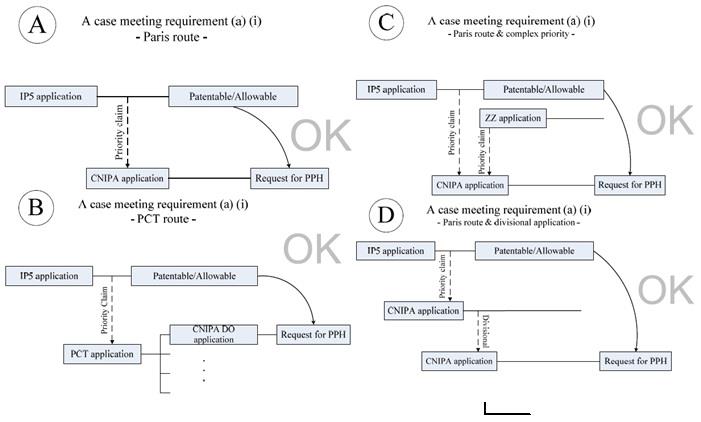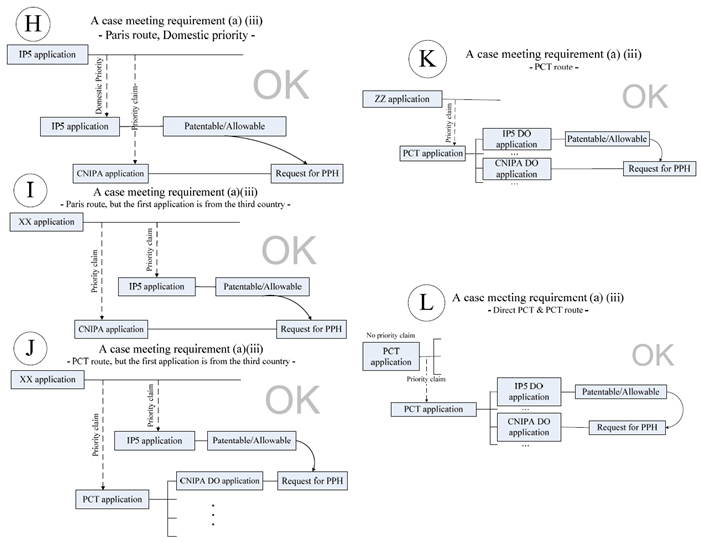Applicants
can request accelerated examination by a prescribed procedure including
submission of relevant documents on an application which is filed with the
CNIPA and satisfies the following requirements under the IP5 PPH pilot program based
on an EPO, JPO, KIPO or USPTO application. The pilot period of this IP5 PPH
pilot program commenced on January 6, 2014, and will end on January 5, 2023
which may be extended then. Applicants can request accelerated examination by a
prescribed procedure including submission of relevant documents on an
application which is filed with the CNIPA under the IP5 PPH pilot program.
PPH using the national/regional work products from
the EPO, JPO, KIPO or USPTO
1. Requirements
In
order to be eligible to participate in the IP5 PPH pilot program at the CNIPA,
the following requirements must be met:
(a) The CNIPA
application for which participation in the IP5 PPH pilot program is requested
must have the same earliest date whether this be the priority or filing date of
a corresponding national/regional application(s) filed with another IP5 Office.

Fig 1 An
application which validly claims priority under the Paris Convention to the
corresponding application(s) filed with another IP5 Office

Fig 2 An application which is the basis of a valid priority claim under the Paris Convention for the corresponding application(s) filed with another IP5 Office (including PCT national phase application(s))

Fig 3 An
application which shares a common priority document with the corresponding
application(s) filed with another IP5 Office (including PCT national phase
application(s))

Fig 4 A
PCT national phase application where both the CNIPA application and the corresponding
application(s) filed with another IP5 Office are derived from a common PCT
international application having no priority claim
(b)
At least one corresponding application exists in another IP5 office and the corresponding
application(s) has/have at least one claim indicated by that IP5 office in its
capacity as a national/regional office to be allowable/patentable.
(c)
All claims in the CNIPA application (for which an accelerated examination under
the IP5 PPH pilot program is requested), as originally filed or as amended,
must sufficiently correspond to one or more of those claims determined to be patentable/allowable
in the corresponding application filed with another IP5 Office.
(d) The CNIPA
application must have been published.
(e) The CNIPA
application must have entered into the substantive examination stage.
(f) The CNIPA
has not begun examination of the application at the time of request for the
PPH.
(g) The CNIPA
application must be electronic patent application.

Fig 5 Examples
of which do not meet the requirements d-f and one exception
2.
Documents to be submitted
(a)
Copies of all office actions (which are relevant to substantive examination for
patentability in another IP5 Office, including search report, search opinion)
which were issued for the corresponding application by another IP5 Office, and translations
of them.
(b)
Copies of all claims determined to be patentable/allowable in the corresponding
application by another IP5 Office, and translations of them.
(c)
Copies of references cited by the examiner in another IP5 Office.
(d)
Claim correspondence table, which indicates how all claims in the CNIPA
application sufficiently correspond to the patentable/allowable claims in the
corresponding application(s) filed with another IP5 Office.
PCT-PPH using the PCT international work products
from the EPO, JPO, KIPO or USPTO
Applicants can
request accelerated examination by a prescribed procedure including submission of relevant
documents on an application which is filed with the CNIPA and satisfies the following
requirements under the IP5 PPH pilot program based on PCT international work
products from the EPO, JPO, KIPO or USPTO (PCT-PPH pilot program).
1. Requirements
In order to be eligible to participate
in the IP5 PPH pilot program at the CNIPA, the following requirements must be
met:
(1) The latest work product in the
international phase of a PCT application corresponding to the application
(“international work product”), namely the Written Opinion of International
Searching Authority (WO/ISA), the Written Opinion of International Preliminary
Examining Authority (WO/IPEA) or the International Preliminary Examination
Report (IPER), indicates at least one claim as patentable/allowable (The claim(s)
determined as novel, inventive and industrially applicable by the ISA and/or IPEA
has/have the meaning of patentable/allowable for the purposes of this
document.).
(2) The relationship between the
application and the corresponding international application satisfies one of
the following requirements:
(A) The application
is a national phase application of the corresponding international application.

Fig 6 Examples
meeting the requirement A
(B) The application is a national application as a basis of the priority claim of the corresponding international application.

Fig 7 An example
meeting the requirement B
(C) The application is a national phase application of an international application claiming priority from the corresponding international application.

Fig 8 An example
meeting the requirement C
(D) The application is a national
application claiming foreign/domestic priority from the corresponding
international application.

Fig 9 An
example meeting the requirement D
(E) The application is the derivative application (divisional
application and application claiming domestic priority etc.) of the application
which satisfies one of the above requirements (A) – (D).

Fig 10 Examples
meeting the requirement E
(3) All claims, as originally filed
or as amended, for examination under the PCT-PPH must sufficiently correspond
to one or more of those claims indicated to be patentable/allowable in the
latest international work product of the corresponding international
application by the EPO, JPO, KIPO, or USPTO as ISA/IPEA.
(4) The application must have
been published.
(5) The application must have
entered into substantive examination stage.
(6) The CNIPA has not begun
examination of the application at the time of request for the PCT-PPH.
(7) The application must be
electronic patent application.
2. Documents to be submitted
Documents (1) to (4) below
must be submitted by attaching to “Request for Participation in the Patent
Prosecution Highway Pilot Program”.
(1) A copy of the latest work product
in the international phase of the corresponding PCT application, the WO/ISA or,
where a demand under PCT Chapter II has been filed, the WO/IPEA or the IPER
which indicated the claims to be patentable/allowable and their Chinese or
English translations.
(2) A copy of a set of claims
which the latest international work product of the corresponding international
application indicated to be patentable/allowable and their Chinese or English
translations.
(3) A copy of references cited
in the latest international work product of the corresponding international
application.
(4) A claims correspondence
table which indicates how all claims in the application sufficiently correspond
to the claims indicated to be patentable/allowable in the corresponding international
application.